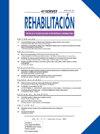Long COVID-19: Impact of a personalized rehabilitation program
Q3 Medicine
引用次数: 0
Abstract
Introduction
Several guidelines have proposed specific rehabilitation programs to treat symptoms/sequelae in patients with post-acute COVID syndrome (PACS). Only a few studies show that rehabilitation reduce disability after COVID-19.
Objective
To describe the response to a personalized rehabilitation program in terms of exercise tolerance, muscle function, dyspnea, quality of life, and frailty state in a cohort of patients with PACS.
Methods
Observational prospective cohort study of community-dwelling patients. The rehabilitation program included three modalities (outpatient, home-based, and self-administered), optionally supplemented with respiratory muscle training. Study variables: 6-minute walking distance (6MWD), inspiratory muscle strength (PImax), dyspnea, muscle strength (estimated with the Medical Research Council scale and handgrip), health-related quality of life (HRQoL), and frailty estimated with the Short Physical Performance Battery (SPPB) and at 3- and 6-months following baseline.
Results
Of 178 patients with PACS, 101 (56.7%) were enrolled in a rehabilitation program: 41.6% home-based, 27.7% outpatient, and 24.8% self-administered. Inspiratory muscle training (IMT) was provided to 56 patients, with 50 included in the rehabilitation program and 6 (5.9%) receiving IMT alone. Significant improvements were observed at 3 months in mMRC strength (p = 0.001), SPPB (p < 0.0001), handgrip strength (p = 0.017), mMRC dyspnea, PImax (p < 0.0001), and 6-MWD (p = 0.008). Improvements persisted at 6 months for mMRC strength (p = 0.048), SPPB (p = 0.002), PImax (p < 0.0001), and 6MWD (p = 0.048). HRQoL mental and physical component scores improved only at 3 months.
Conclusions
Personalized rehabilitation for patients with PACS improved muscle parameters, dyspnoea, and exercise capacity, but not HRQoL, up to 6 months. Improvements in respiratory muscle strength were associated with reductions in dyspnoea and increased exercise capacity.
长期COVID-19:个性化康复计划的影响
一些指南提出了特定的康复方案来治疗急性后COVID综合征(PACS)患者的症状/后遗症。只有少数研究表明,康复可以减少COVID-19后的残疾。目的描述PACS患者在运动耐量、肌肉功能、呼吸困难、生活质量和虚弱状态方面对个性化康复计划的反应。方法对社区住院患者进行观察性前瞻性队列研究。康复计划包括三种模式(门诊、家庭和自我管理),选择性地辅以呼吸肌训练。研究变量:6分钟步行距离(6MWD)、吸气肌力量(PImax)、呼吸困难、肌肉力量(用医学研究委员会量表和握力评估)、健康相关生活质量(HRQoL)和虚弱程度(用短体能性能测试(SPPB)评估,基线后3个月和6个月。结果178例PACS患者中,101例(56.7%)参加了康复计划,其中41.6%为家庭康复,27.7%为门诊康复,24.8%为自我康复。56例患者接受了吸气肌训练(IMT),其中50例纳入康复计划,6例(5.9%)单独接受了吸气肌训练。3个月时mMRC强度(p = 0.001)、SPPB (p <;0.0001),握力(p = 0.017), mMRC呼吸困难,PImax (p <;0.0001)和6-MWD (p = 0.008)。6个月后mMRC强度(p = 0.048)、SPPB (p = 0.002)、PImax (p <;0.0001), 6MWD (p = 0.048)。HRQoL精神和身体成分评分仅在3个月时改善。结论个性化康复治疗可改善PACS患者6个月前的肌肉参数、呼吸困难和运动能力,但没有改善HRQoL。呼吸肌力量的改善与呼吸困难的减少和运动能力的增加有关。
本文章由计算机程序翻译,如有差异,请以英文原文为准。
求助全文
约1分钟内获得全文
求助全文
来源期刊

Rehabilitacion
Medicine-Rehabilitation
CiteScore
0.80
自引率
0.00%
发文量
63
期刊介绍:
La revista que es desde hace más de 40 años la publicación oficial de la Sociedad Española de Rehabilitación y referente de la mayoría de las Sociedades de la Especialidad de los países americanos de habla hispana. Se publican 5 números pluritemáticos al año y uno monográfico sobre un tema del mayor interés y actualidad designado por el consejo de redacción.
 求助内容:
求助内容: 应助结果提醒方式:
应助结果提醒方式:


